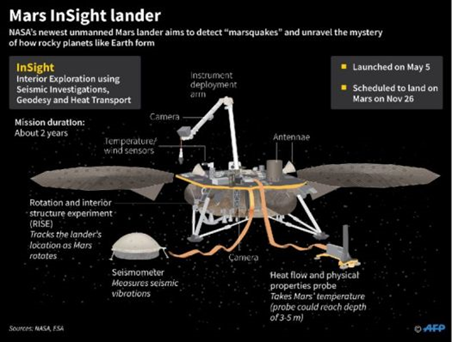

NASA’s Mars Lander InSight has recorded its first ‘Marsquake.’ It has recorded a quake of 2 or 2.5 magnitude which is hard to predict on Earth’s surface.
Context
NASA’s Mars Lander InSight has recorded its first ‘Marsquake.’ It has recorded a quake of 2 or 2.5 magnitude which is hard to predict on Earth’s surface.
About
- InSight is part of NASA’s Discovery Program, managed by the agency’s Marshall Space Flight Center in Huntsville, Alabama.
- It will be the first mission to peer deep beneath the Martian surface, studying the planet’s interior by measuring its heat output and listening for marsquakes, which are seismic events similar to earthquakes on Earth.

- It will use the seismic waves generated by marsquakes to develop a map of the planet’s deep interior.
Significance of the mission:
- The findings of Mars’ formation will help better understand how other rocky planets, including Earth, were and are created. But InSight is more than a Mars mission – it is a terrestrial planet explorer that would address one of the most fundamental issues of planetary and solar system science – understanding the processes that shaped the rocky planets of the inner solar system (including Earth) more than four billion years ago.
- InSight would delve deep beneath the surface of Mars, detecting the fingerprints of the processes of terrestrial planet formation, as well as measuring the planet’s “vital signs”: Its “pulse” (seismology), “temperature” (heat flow probe), and “reflexes” (precision tracking).
- InSight seeks to answer one of science’s most fundamental questions: How did the terrestrial planets form?
- Previous missions to Mars have investigated the surface history of the Red Planet by examining features like canyons, volcanoes, rocks and soil. However, signatures of the planet’s formation can only be found by sensing and studying its “vital signs” far below the surface.
- In comparison to the other terrestrial planets, Mars is neither too big nor too small. This means that it preserves the record of its formation and can give us insight into how the terrestrial planets formed. It is the perfect laboratory from which to study the formation and evolution of rocky planets. Scientists know that Mars has low levels of geological activity. But a lander like InSight can also reveal just how active Mars really is.


